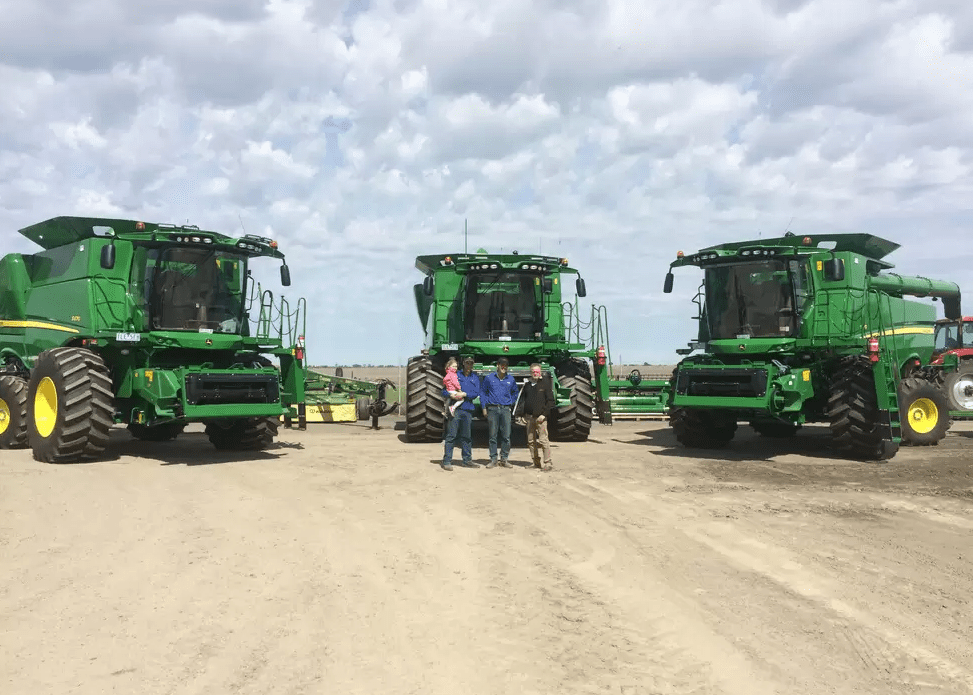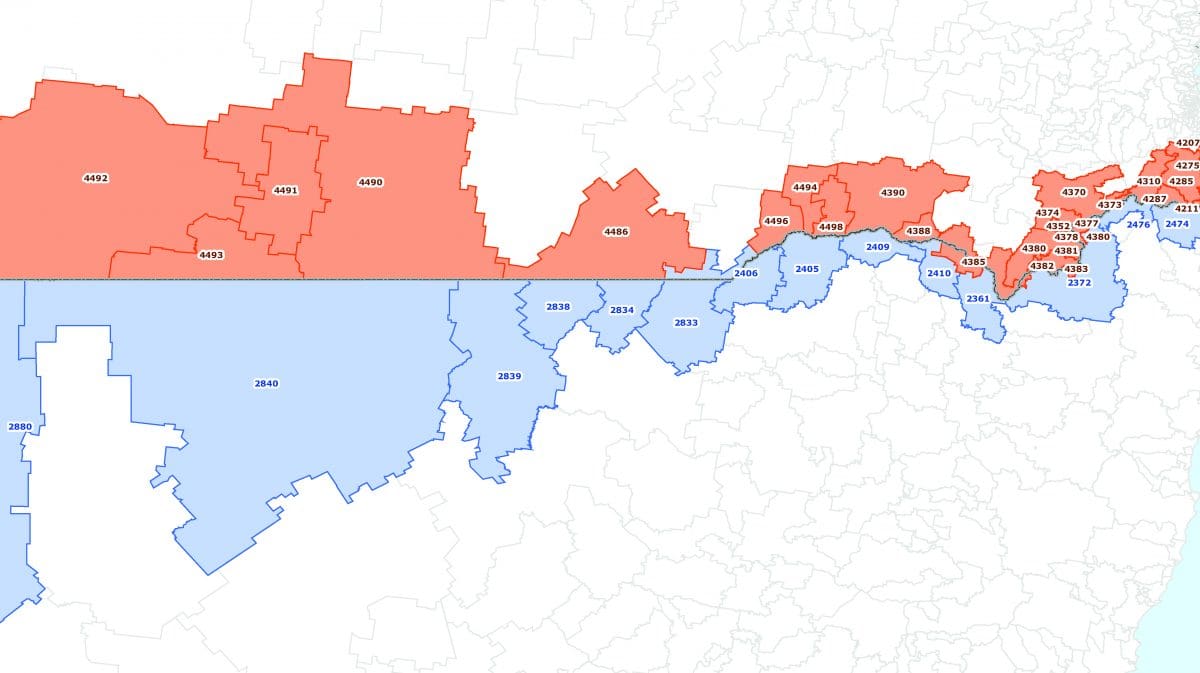
Many contract harvesters are hoping they can operate in two or three states in the upcoming harvest despite COVID restrictions on border movements. Photo: Bartlett Brothers Harvesting
CONTRACT harvesters based in New South Wales and Victoria are hoping to gain exemptions from the Queensland Government which will allow them to harvest crops in Queensland in the face of new restrictions aimed at limiting the spread of COVID-19.
Introduced on Saturday, the Queensland Health Border Restrictions Direction No. 11 says time-critical specialist workers in essential industries including agribusiness can apply for exemptions to the border closure.
AgForce grains policy director Cam Parker said refusals would severely restrict the ability of interstate contractors to bolster Queensland’s harvesting capabilities to maximise crop value in what was forecast to be a wet spring.
“We need to articulate a case to the Queensland Health Officer Jeanette Young that says contract harvesters and their crews are essential, and why,” Mr Parker said.
AgForce is working with national lobby group Australian Custom Harvesters (ACH), and with the Queensland Department of Agriculture and Fisheries (QDAF), with support from Grain Producers Australia (GPA), to develop a pro forma for contractors to follow for their applications to work in Queensland this harvest.
It is expected to include details of crew members and their work locations in Queensland, as well as the workload they are expecting, to support a case for why Queensland contractors alone will not be able to handle the crop.
“Our number-one priority is to keep COVID out of Queensland, and our number-two priority is to get the crop off in a timely manner,” Mr Parker said.
Need starts next month
As usual, this year’s Australian winter-crop harvest will start in small volume in Central Queensland later this month.
By the time it gathers pace in September, interstate contractors in all but the worst of drought years are called upon to help get the crop off.
Prior to Direction 11 coming into effect, some contractors from Victoria and NSW were already taking machines north.
Direction 11 has identified postcode zones either side of the NSW-Queensland border which can operate within a bubble, and AgForce is seeking extensions to those to cater for movements during harvest.
“We’re mounting a case for additional postcodes to be added.”
Mr Parker said up to 20 contractors in total from NSW and Victoria could be applying for permission to work on the harvest in Queensland, where many districts in southern Queensland are expecting their biggest crop since 2016.
“That’s particularly the case around Thallon and Goondiwindi and towards Mungindi.
“It’s a work in progress, and we believe we have a compelling case for crops which will otherwise struggle to be harvested in a timely manner.”
Mr Parker said indications of La Nina conditions strengthening in spring made the timely harvest of crops all the more important to ensure value to grower, regional, state and national economies was maximised.
However, he said NSW and Victorian contractors might not be granted permission to work in all parts of Queensland if authorities determined that the harvest task could be completed without assistance from interstate operators.
Multi-party discussions
ACH president Rod Gribble, who is based in the NSW Riverina, said ACH was in discussions with NSW Farmers, Victorian Farmers Federation and GPA as well as AgForce about the issue of harvesting the eastern Australian crop amid border restrictions.
“What we’re trying to do is inform the NSW Chief Medical Officer and Queensland’s Chief Health Officer, because they have the ultimate power about who can get exemptions to cross borders,” Mr Gribble said.
He said ACH and state-based organisations were in discussions with state agriculture departments, which were in turn communicating with health departments, around what exemptions were needed to complete cross-border harvest tasks.
“That extends to growers with farms on either side of the NSW border that need to move machinery and staff from one state to the other when we get to harvest.
“GPA has done work in the background on that, and we’re trying to work out a protocol, and trying to inform state health departments through the ag departments about how many people we think will need to cross borders, and how many times they’ll have to do it.
“We understand they have got to stay in that harvesting area.
“A lot of people are going to be moving machines from Victoria to NSW, or NSW to Queensland this harvest.
“At this stage we’re not sure if Victorians will be allowed into Queensland.
“Let’s just hope there’s an outbreak of common-sense so people working this harvest can get across borders if they need to.”

Border zone postcodes entitle residents to some freedom of movement across the NSW-Queensland border. Image: Queensland Government
Eyes on CQ
Talbot Ag Contracting principal Damian Talbot, based at Narromine in NSW, has booked a truck to take his header to the Mt McLaren district in Central Queensland (CQ) early next month.
“I know my transport can get in, but I’m trying to find out if I can get in.
“I don’t want to have to quarantine in Queensland for two weeks.”
Mr Talbot said half his harvesting income typically came from Queensland, and he would roll from CQ to the Condamine district on the Western Downs before returning in November to Narromine where canola would kick off the local harvest program.
Double crossing from Victoria
In Victoria, Bartlett Brothers Harvesting operates six headers, and plans to take three or four to the west of Goondiwindi to kick off its harvest program.
Co-principal Chris Bartlett said their first header went to Queensland last week.
“We got into Queensland with a transport permit at Goondiwindi no problem, and into NSW at Barham-Koondrook, but we mightn’t get over with an ag permit.
“I know governments are still working on policies, and we’re hoping the ag sector, particularly during harvest, doesn’t hit any hindrances.”
The Bartletts hope to be able to take another two or three harvesters into Queensland in the next fortnight to start their run in early October.
This is expected to preceed their move into NSW to harvest at Garah and then Trangie, jobs that are expected to call for all six of their machines and both chaser bins, and then roll the whole show south to the southern Mallee in Victoria before their season ends around New Year.
“It’s going to be a thumping year in NSW, and it’s going to impact our business if we can’t do the big season that’s coming.
“We’ve bought two new machines, and we’ve got payments to make.”
Mr Bartlett said the business normally employed some overseas workers during harvest, and one impact of COVID had been the need to advertise for staff.
“We haven’t had to advertise before.”
The Bartlett crew numbers up to 10 during harvest. Mr Bartlett said even without COVID, harvest teams work largely in isolation and bunk in self-contained accommodation on site.
“The only time we go to town is to get spare parts and groceries.”
If the Queensland Government grants exemption to interstate contractors, those trips may be prohibited.
“They might need to get someone to go to town and do it for them.
“Every contracting business that wants to come to Queensland for harvest is going to have to formulate a plan that will work for them and for Queensland.”
Grain Central: Get our free daily cropping news straight to your inbox – Click here



HAVE YOUR SAY